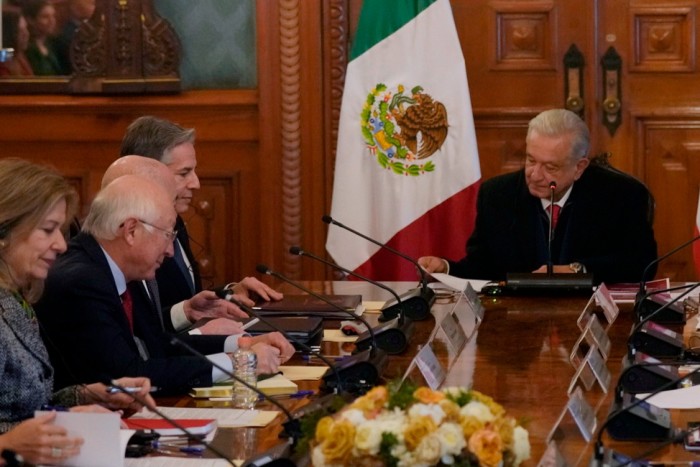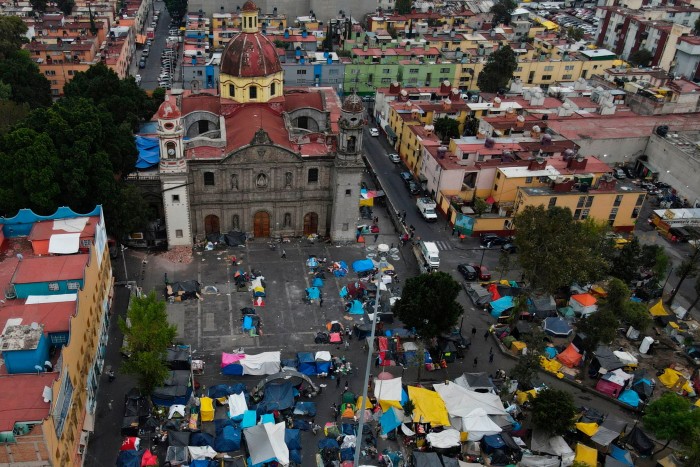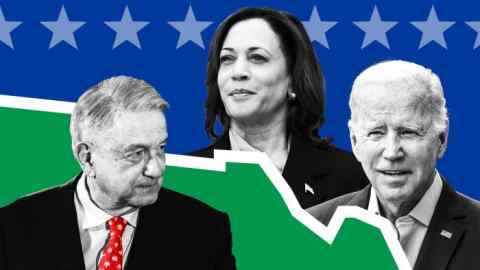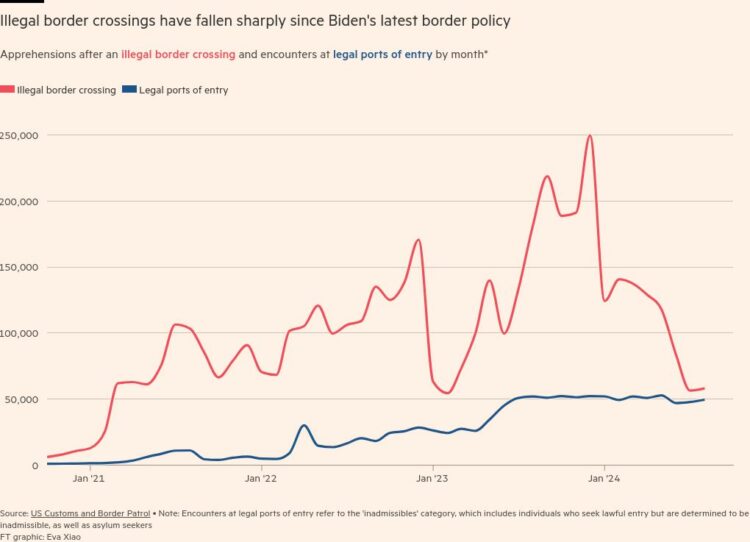Carmen left her home in Peru this year hoping for a better life in the US. Instead, the 26-year-old has been living by an abandoned train track in Mexico City for months, lacking water or even a toilet, while waiting for an appointment to cross the border.
“If I’d known, believe me, I wouldn’t have risked it, especially for my children,” she said, breastfeeding the youngest of her three children outside a makeshift home of wood and tarpaulin. “We tell each other that ‘we have to keep going, keep going’.”
Carmen is part of a broader trend that surprised migration experts and policymakers this year: a sharp drop in the number of people found crossing the US border, just as the country gears up for its presidential election.
A combination of factors has contributed: tougher US punishment for illegal crossings, more options to enter legally and more active enforcement across Mexico and Central America. Just 56,000 people crossed the US’s southern border in July, down from a record 220,000 in December.
Crossings have been falling steadily since February. Despite a small uptick in August, border encounters were 68 per cent lower than the same month a year ago. That has put the US on track for the lowest annual number of apprehensions since the Covid-19 pandemic began in 2020, according to government data.
The record number of migrants at the border became a political crisis for President Joe Biden that threatened to derail his re-election ambitions, and subsequently the campaign of his vice-president Kamala Harris after he bowed out of the race, with voters citing it as their top concern in some polls.
“It’s a pretty dramatic shift,” said Andrew Selee, president of the US-based Migration Policy Institute. “After more than three years of high numbers, unauthorised crossings are suddenly back to where they were four years ago.”
To tackle the border, the Biden administration has tried several tactics. In December last year, secretary of state Antony Blinken flew to Mexico and pressed President Andrés Manuel López Obrador to step up the detaining and busing of migrants back south. Then in June, days after the Mexican presidential election, Biden made it much harder for migrants to request asylum if they crossed illegally, intensifying a push to have them use an app to make an appointment to apply.
 Mexican President Andrés Manuel López Obrador, right, meets US secretary of state Antony Blinken, top left, in Mexico City in December last year © Fernando Llano/AP
Mexican President Andrés Manuel López Obrador, right, meets US secretary of state Antony Blinken, top left, in Mexico City in December last year © Fernando Llano/AP
A parole programme introduced late last year allows up to 30,000 pre-screened people from Cuba, Haiti, Venezuela and Nicaragua — all of which are facing political and economic turmoil — to enter the US each month.
While that has relieved pressure at the border — US Customs and Border Protection says encounters with individuals from those countries between ports of entry are down 99 per cent — it means that legal migration has risen, and opened up a new line of political attack from Republicans.
Migrants from the programme have settled in towns across the US, where Republicans claim they are overwhelming social services and schools, and setting up a cultural clash that has unsettled some residents.
During the first, and possibly only, presidential debate between Harris and Donald Trump, the Republican candidate homed in on discredited stories of Haitian immigrants in the town of Springfield, Ohio, eating pets.
“They’ve destroyed the fabric of our country. Millions of people let in,” Trump said during the debate.
Harris has tried to turn the tables on Trump by accusing him of lobbying against a bill in Congress that sought to boost security at the border in order to reap the political benefits of chaotic scenes there.
The effects of the changes in Biden’s policy are visible in Mexico too. Now, instead of clustering in dangerous border cities, migrants are scattered across the country, say advocates. Informal camps have sprung up in several parts of Mexico City, which is safer and offers work opportunities.
“Maybe 18 months ago it wasn’t common to see these street camps in Mexico City . . . now it’s normal,” said Lizbeth Guerrero, co-founder of non-profit Apoyo a Migrantes Venezolanos.
 A migrant tent encampment in the La Merced neighbourhood of Mexico City © Marco Ugarte/AP
A migrant tent encampment in the La Merced neighbourhood of Mexico City © Marco Ugarte/AP
Advocates say the new system is better in some ways, offering many people a safer way to cross the border, but neither the US nor Mexico has created adequate infrastructure to protect the migrants or limit their impact on local populations.
“Hundreds of people are seemingly, in a matter of a few days, suddenly camping in a place with absolutely no facilities,” said Kennji Kizuka, director of asylum policy at the International Rescue Committee. “[Humanitarian groups are] struggling to meet even the most basic needs for food, water, shelter . . . information.”
There are 1,450 appointments available each day for those seeking asylum in the US via the app that the US and Mexican governments have promoted. It is not enough to meet demand, with the backlog growing in Mexico and many migrants waiting for more than six months. It also means that many people who need asylum protection are simply not getting seen, said Kizuka.
Recommended

Some Democrats are uneasy with the tougher border rules that Biden has implemented, and many of the policies are facing legal challenges. The reduction in crossings might also prove shortlived, said Adam Isacson, a migration expert at the Washington Office on Latin America.
“Ultimately, it is not sustainable . . . migrants and smugglers figure out who the policies most apply to and who they don’t,” he said.
Policies south of the border, in co-operation with regional leaders, are also crucial to sustaining a fall in crossings. Panama’s new President José Raúl Mulino has taken US funding to deport migrants who cross the Darién Gap, a perilous 70-mile stretch of jungle bordering Colombia that is used as a route to the US. Just 16,600 people crossed in August, a fifth of the number a year earlier, government statistics show.
Mexico’s incoming president, Claudia Sheinbaum, who will take office in October, has signalled she intends to continue López Obrador’s policies, something that, at least on migration, would please Washington. A new Mexican government programme to bus migrants from the south directly to the US border if they have an appointment to cross may encourage them to wait there.
No matter what happens, migrants such as Walyelis Chirinos, living in an informal Mexico City camp with her partner, child and grandchildren, are prepared to endure.
“If we had to wait a really long time, I would, but we won’t go back to Venezuela, we can’t go back” she said.
Source link : http://www.bing.com/news/apiclick.aspx?ref=FexRss&aid=&tid=66f23c74815e4f909b27ee8f11307b9d&url=https%3A%2F%2Fwww.ft.com%2Fcontent%2F8b74d49a-9d46-441f-bc1a-539a76e0c8aa&c=7289552907547215685&mkt=en-us
Author :
Publish date : 2024-09-23 17:00:00
Copyright for syndicated content belongs to the linked Source.
